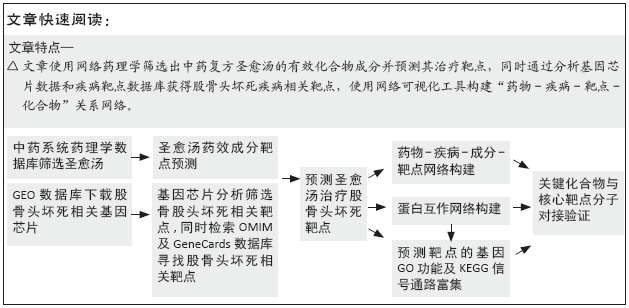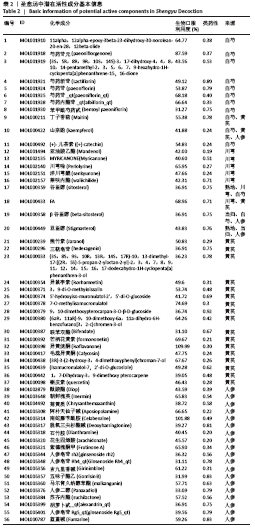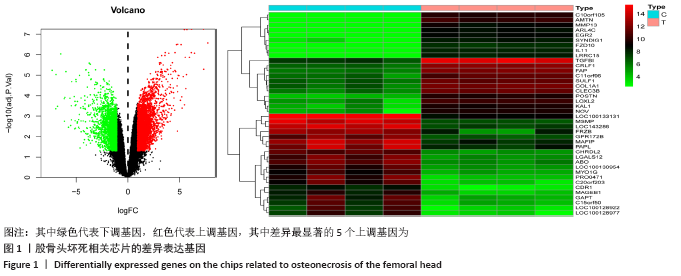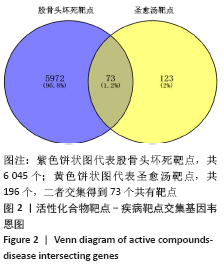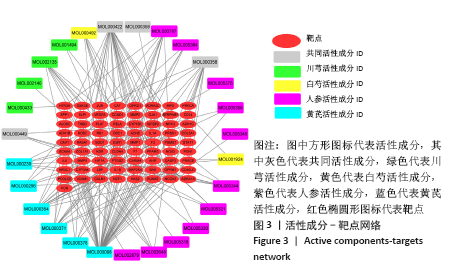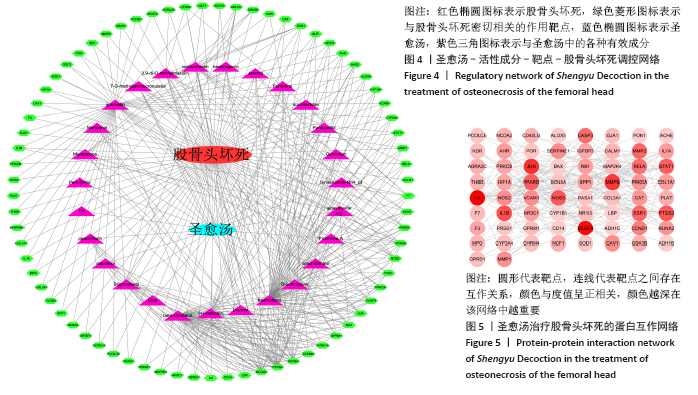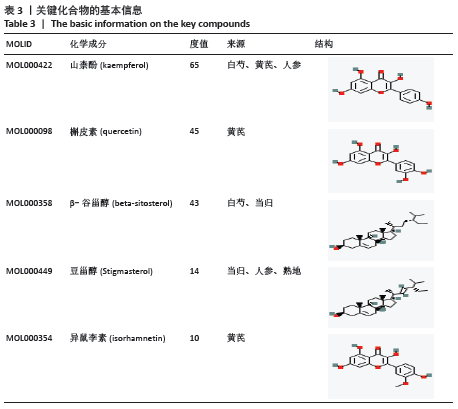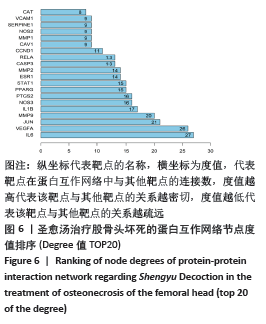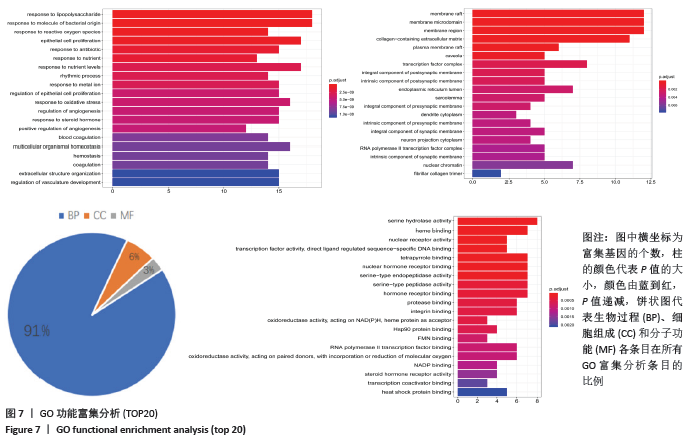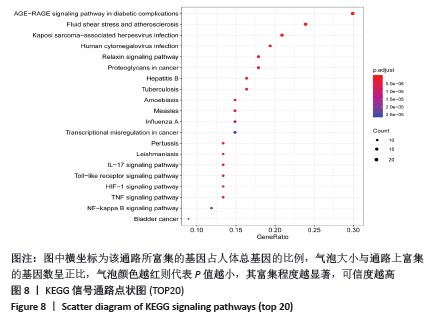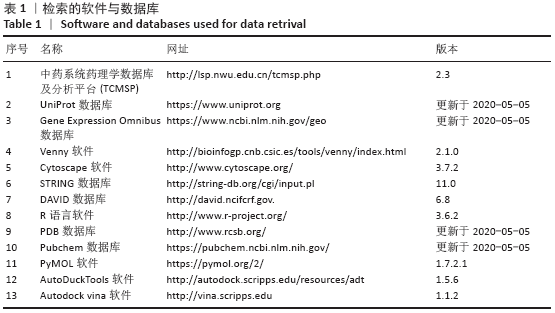[1] 赵德伟,胡永成.成人股骨头坏死诊疗标准专家共识(2012年版)[J].中华关节外科杂志(电子版),2012,6(3):479-484
[2] ZHAO DW, YU M, HU K, et al. Prevalence of nontraumatic osteonecrosis of the femoral head and its associated risk factors in the chinese population: results from a nationally representative survey. Chin Med J (Engl). 2015;128(21):2843-2850.
[3] 周明旺,陈彦同,李盛华,等.股骨头坏死保髋治疗[J].中国骨质疏松杂志,2019, 25(9):1351-1356.
[4] 陈卫衡,何伟,童培建,等.股骨头坏死中医辨证标准(2019年版)[J].中医正骨, 2019,31(6):1-2.
[5] 王晨,施杞.施杞辨治股骨头坏死经验撷菁[J].上海中医药杂志,2015,49(11):1-3.
[6] 刘粉叶,沙其朋,王娓娓.益气养血法对骨髓抑制小鼠骨髓造血的促增殖作用及机制[J].中华中医药学刊,2019,37(10): 2328-2331.
[7] HAI YX, YAN QZ, ZHEN ML, et al. ETCM: an encyclopaedia of traditional Chinese medicine. Nucleic Acids Res. 2019;47(D1): D976-D982.
[8] EDGAR R, DOMRACHEV M, LASH AE. Gene Expression Omnibus: NCBI gene expression and hybridization array data repository. Nucleic Acids Res. 2002;30(1):207-210.
[9] TROTT O, OLSON AJ. AutoDock Vina: improving the speed and accuracy of docking with a new scoring function, efficient optimization, and multithreading[J]. J Comput Chem. 2010;31(2):455-461.
[10] 徐森楠,庄莉,翟园园,等.基于网络药理学研究二至丸防治骨质疏松症的物质基础与作用机制[J].中国药学杂志,2018, 53(22):1913-1920.
[11] YU X, ZHANG D, CHEN X, et al. Effectiveness of various hip preservation treatments for non-traumatic osteonecrosis of the femoral head: a network meta-analysis of randomized controlled trials. J Orthop Sci. 2018;23(2):356-364.
[12] PISANI LP, ESTADELLA D, RIBEIRO DA. The role of toll like receptors (TLRs) in oral carcinogenesis. Anticancer Res. 2017; 37(10):5389-5394.
[13] GÜLER-YÜKSEL M, HOES JN, BULTINK IEM, et al. Glucocorticoids, Inflammation and Bone. Calcif Tissue Int. 2018;102(5): 592-606.
[14] JOHNSON RW, MCGREGOR NE, BRENNAN HJ, et al. Glycoprotein130 (Gp130)/interleukin-6 (IL-6) signalling in osteoclasts promotes bone formation in periosteal and trabecular bone. Bone. 2015;2015(81): 343-351.
[15] TANAKA Y, TAKEUCHI T, AMANO K, et al. Effect of interleukin-6 receptor inhibitor, tocilizumab, in preventing joint destruction in patients with rheumatoid arthritis showing inadequate response to TNF inhibitors. Modern Rheumatol. 2014;24(3): 399-404.
[16] LANGE J, SAPOZHNIKOVA A, LU C, et al. Action of IL-1beta during fracture healing. J Orthop Res. 2010;28(6):778-784.
[17] CZEKANSKA EM, RALPHS JR, ALINI M, et al. Enhancing inflammatory and chemotactic signals to regulate bone regeneration. Eur Cell Mater. 2014;28:320-334.
[18] VOSS JO, LOEBEL C, BARA JJ, et al. Effect of short-term stimulation with interleukin-1β and differentiation medium on human mesenchymal stromal cell paracrine activity in coculture with osteoblasts. BioMed Res Int. 2015;2015:714230.
[19] 郭成龙,魏玉娇,何玲,等.生骨再造丸对激素性股骨头坏死大鼠骨代谢及炎症细胞因子表达的影响[J].中药药理与临床,2019,35(4):170-174.
[20] 帅波,沈霖,杨艳萍,等.古方青娥丸加味干预早期非创伤性股骨头缺血性坏死骨转换标志物、血流变及炎症相关因子的变化[J].中国组织工程研究,2016, 20(46):6907-6914.
[21] SODHI CP, NEAL MD, SIGGERS R, et al. Intestinal epithelial Toll-like receptor 4 regulates goblet cell development and is required for necrotizing enterocolitis in mice. Gastroenterology. 2012;143(3): 708-718.
[22] YAMAGUCHI M, WEITZMANN MN. Quercetin,a potent suppressor of NF-κB and Smad activation in osteoblasts. Int J Mol Med. 2011;28(4):521-525.
[23] BELLEI B, PITISCI A, IZZO E, et al. Inhibition of melanogenesis by the pyridinyl imidazole class of compounds: possible involvement of the Wnt/β-catenin signaling pathway. PLoS One. 2012;7(3):e33021.
[24] MENG L, SUN JY. Progression of TLR4 signal pathway in osteoblast. Chinese J Osteop Bone Mineral Res. 2013;6(3):260-265.
[25] 李文锋,侯树勋,张伟佳,等.TNF-α-NF-κB对成骨细胞分化过程中BMP-2-Smad1信号通路的影响[J].中国骨质疏松杂志, 2011,17(1):1-4.
[26] 李知玻,李子锋,章莹,等. TNF-α对成骨细胞凋亡作用的探讨[J].中国骨质疏松杂志,2012,18(10):892-894.
[27] GLASS GE, CHAN JK, FREIDIN A, et al. TNF-alpha promotes fracture repair by augmenting the recruitment and differentiation of muscle-derived stromal cells. Proc Natl Acad Sci USA. 2011;108(4): 1585-1590.
[28] LI JK, CHENG L, ZHAO YP, et al. ADAMTS-7 exhibits elevated expression in cartilage of osteonecrosis of femoral head and has a positive correlation with TNF- α and NF- κB P65. Mediators Inflamm. 2015; 2015:196702.
[29] CHEN G, DENG C, LI YP. TGF-β and BMP signaling in osteoblast differentiation and bone formation. Int J Biol Sci. 2012;8(2): 272-288.
[30] ZHANG JR, PANG DD, TONG Q, et al. Different modulatory effects of IL-17, IL-22, and IL-23 on osteoblast differentiation. Mediators Inflamm. 2017;2017:5950395.
[31] HUANG H, KIM HJ, CHANG EJ, et al. IL-17 stimulates the proliferation and differentiation of human mesenchymal stem cells: implications for bone remodeling. Cell Death Differ. 2009;16(10):1332-1343.
[32] ZHAO L, LIU Z, YANG F, et al. Intrabody against prolyl hydroxylase 2 promotes angiogenesis by stabilizing hypoxia-inducible factor-1α. Sci Rep. 2019;9(1):11861.
[33] LI J, FAN L, YU Z, et al. The effect of deferoxamine on angiogenesis and bone repair in steroid-induced osteonecrosis of rabbit femoral heads. Exp Biol Med (Maywood). 2015;240(2):273-280.
[34] ZHANG W, YUAN Z, PEI X, et al. In vivo and in vitro characteristic of HIF-1α and relative genes in ischemic femoral head necrosis. Int J Clin Exp Pathol. 2015;8(6):7210-7216.
[35] MA W, XIN K, CHEN K, et al. Relationship of common variants in VEGFA gene with osteonecrosis of the femoral head: a Han Chinese population based association study. Sci Rep. 2018;8(1):16221.
[36] SONG J, JING Z, HU W, et al. α-linolenic acid inhibits receptor activator of NF-κB ligand induced (RANKL-Induced) osteoclastogenesis and prevents inflammatory bone loss via downregulation of nuclear factor-kappaB-inducible nitric oxide synthases (NF-κB-iNOS) signaling pathways. Med Sci Monit. 2017;23: 5056-5069.
[37] 徐涛涛,劳杨骏,廖菲,等.HIF-1α信号通路与激素性股骨头坏死相关性研究进展[J].世界中西医结合杂志,2015,10(5):730-733.
[38] WU J, YAO L, WANG B, et al. Tao-Hong-Si-Wu Decoction ameliorates steroid-induced avascular necrosis of the femoral head by regulating the HIF-1α pathway and cell apoptosis. Biosci Trends. 2016;10(5): 410-417.
[39] CASADO-DÍAZ A, ANTER J, DORADO G, et al. Effects of quercetin, a natural phenolic compound, in the differentiation of human mesenchymal stem cells (MSC) into adipocytes and osteoblasts. J Nutr Biochem. 2016;32:151-162.
[40] GE YW, FENG K, LIU XL, et al. Quercetin inhibits macrophage polarization through the p-38α/β signalling pathway and regulates OPG/RANKL balance in a mouse skull model. Cell Mol Med. 2020;24(5): 3203-3216.
[41] KIM IR, KIM SE, BAEK HS, et al. The role of kaempferol-induced autophagy on differentiation and mineralization of osteoblastic MC3T3-E1 cells. BMC Complement Altern Med. 2016;16(1):333.
[42] 刘威良,姬昱,黄艾祥.β-谷甾醇的研究及开发进展[J].农产品加工,2019, (1):77-79.
[43] DAS N, BHATTACHARYA A, KUMAR MANDAL S, et al. Ichnocarpus frutescens (L.) R. Br. root derived phyto-steroids defends inflammation and algesia by pulling down the pro-inflammatory and nociceptive pain mediators: an in-vitro and in-vivo appraisal. Steroids. 2018;139:18-27.
[44] CHAUHAN S, SHARMA A, UPADHYAY NK, et al. In-vitro osteoblast proliferation and in-vivo anti-osteoporotic activity of Bombax ceiba with quantification of Lupeol, gallic acid and β-sitosterol by HPTLC and HPLC. BMC Complement Altern Med. 2018;18(1): 233.
[45] GABAY O, SANCHEZ C, SALVAT C, et al. Stigmasterol: a phytosterol with potential anti-osteoarthritic properties. Osteoarthritis Cartilage. 2010;18(1):106-116.
[46] YANG L, CHEN Q, WANG F, et al. Antiosteoporotic compounds from seeds of Cuscuta chinensis. J Ethnopharmacol. 2011;135(2):553-560.
[47] 谢兴文,徐世红,李宁.中药单味或单体诱导骨髓间充质干细胞向成骨细胞分化研究概况[J].中国中医骨伤科杂志,2010, 18(10):65-67.
[48] COOK D, GENEVER P. Regulation of mesenchymal stem cell differentiation. Adv Exp Med Biol. 2013;(786):213-229.
[49] XU S, ZHANG L, JIN H, et al. Autologous stem cells combined core decompression for treatment of avascular necrosis of the femoral head: a systematic meta-analysis. Biomed Res Int. 2017;(2017):6136205.
[50] KANG JS, MOON KH, KIM BS, et al. Clinical results of auto-iliac cancellous bone grafts combined with implantation of autologous bone marrow cells for osteonecrosis of the femoral head:a minimum 5-year follow-up. Yonsei Med J. 2013;54(2):510-515.
[51] 徐凌霄,高俊,张前德.左归丸含药血清对大鼠骨髓间充质干细胞骨向分化中碱性磷酸酶含量的影响[J].中国实验方剂学杂志,2011,17(7):149-152.
[52] 廖清船,肖洲生,秦艳芳,等.植物雌激素金雀异黄酮通过p38MAPK通路促进骨髓间充质干细胞向成骨细胞分化[J].中国药理学通报,2006,22(6):683-687. |
